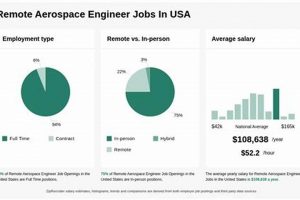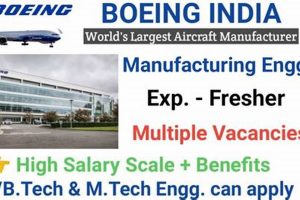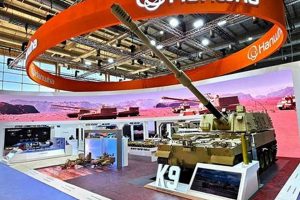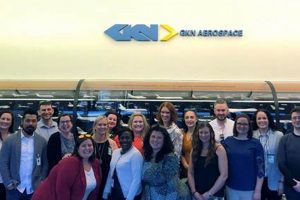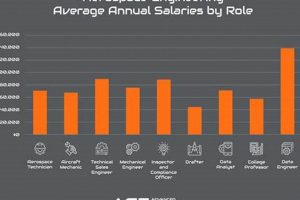Aerospace engineering encompasses the design, development, testing, and production of aircraft, spacecraft, and related systems. Professionals in this field apply principles of physics, mathematics, and engineering to create innovative solutions for air and space travel. For example, an aerospace engineer might design a new type of aircraft wing or develop guidance systems for satellites.
The field of aerospace engineering is vital for advancements in transportation, communication, and scientific exploration. Progress in these domains leads to more efficient air travel, improved satellite-based communication networks, and greater understanding of the universe. Historically, aerospace engineers have been instrumental in major technological leaps, from the development of jet engines to the creation of reusable spacecraft, each contributing to societal progress.
The range of responsibilities undertaken within this field is broad. These can encompass areas such as aerodynamics, propulsion, structural analysis, and control systems. Examining specific roles and project involvement provides a clearer picture of the various career paths available to individuals with expertise in aerospace engineering.
Career Insights for Aspiring Aerospace Professionals
Navigating a career path in aerospace engineering requires strategic planning and continuous development. The following points offer guidance for those pursuing opportunities in this complex field.
Tip 1: Develop a Strong Foundation in Core Subjects: A solid understanding of mathematics, physics, and computer science is essential. Coursework in these areas provides the tools necessary for success in advanced engineering topics.
Tip 2: Specialize in a Specific Area: Aerospace engineering encompasses various specializations, such as aerodynamics, propulsion, or structural analysis. Focusing on a specific area allows for deeper expertise and makes one more competitive in the job market.
Tip 3: Gain Practical Experience Through Internships: Internships provide valuable hands-on experience. Working on real-world projects under experienced engineers offers insights into industry practices and helps develop essential skills.
Tip 4: Enhance Skills in CAD and Simulation Software: Proficiency in software such as MATLAB, ANSYS, or CATIA is highly valued. These tools are widely used in design, analysis, and simulation, making them essential for aerospace engineers.
Tip 5: Pursue Advanced Education: A master’s degree can significantly enhance career prospects, particularly for roles involving research and development. Advanced studies allow for specialization and provide opportunities to conduct independent research.
Tip 6: Develop Strong Communication Skills: Effective communication is crucial for collaborating with teams and presenting technical information. Strong written and verbal communication skills are essential for conveying ideas and working effectively within a team.
Tip 7: Maintain Awareness of Industry Trends: The aerospace industry is constantly evolving. Staying informed about new technologies, materials, and regulations is crucial for remaining competitive and adaptable.
Adherence to these guidelines can significantly improve the prospects of individuals seeking careers in this challenging and rewarding field.
The information presented is designed to help orient prospective aerospace professionals. The next section will focus on educational considerations for a career in aerospace engineering.
1. Design
Design forms a cornerstone of aerospace engineering responsibilities. It is the initial phase where engineers translate conceptual ideas and performance requirements into detailed plans for aircraft, spacecraft, and related systems. Effective design ensures the functionality, safety, and efficiency of the final product. For instance, the design of an aircraft wing requires careful consideration of aerodynamic principles to optimize lift and minimize drag. Errors in this initial design phase can have significant repercussions, impacting performance, safety, and cost-effectiveness during later stages of development and operation.
The application of design principles varies across different areas within aerospace engineering. Structural design focuses on ensuring the integrity of the aircraft or spacecraft, considering factors such as material selection, load-bearing capacity, and resistance to environmental stresses. Propulsion system design involves developing efficient and reliable engines or thrusters, taking into account factors such as fuel efficiency, thrust-to-weight ratio, and emissions. Control system design focuses on creating stable and responsive systems for guidance, navigation, and control, ensuring that the aircraft or spacecraft can be safely and effectively maneuvered. These areas underscore how a systematic design phase ensures effective design, with a goal of effective engineering product.
In summary, design constitutes a critical component of the skill set applied in this sector. Aerospace engineers utilize a blend of theoretical knowledge, practical experience, and computer-aided tools to create innovative and effective designs. The ability to translate complex requirements into functional and reliable designs directly impacts the success and safety of aerospace projects. Continuous refinement of design methodologies and the integration of new technologies are essential to address the evolving challenges and opportunities within the field.
2. Analysis
Within aerospace engineering, analysis is an indispensable function, influencing both design decisions and operational strategies. Aerospace engineers apply diverse analytical techniques to predict and evaluate the performance of aircraft and spacecraft under varying conditions. Structural analysis, for example, assesses the integrity of airframes and components against stresses from flight loads, thermal gradients, and external forces. This analysis determines if a design can withstand these loads without failure. A critical error in stress analysis could lead to catastrophic structural failure during flight, highlighting the importance of rigorous analytical processes. Similar analytical techniques are applied to propulsion systems, aerodynamics, and control systems, each contributing to a comprehensive understanding of the system’s behavior.
Computational Fluid Dynamics (CFD) exemplifies a crucial tool in the analytical process. CFD simulations model airflow around aircraft to optimize aerodynamic efficiency and predict performance characteristics. These simulations are instrumental in refining wing designs, reducing drag, and improving fuel efficiency. Another example is thermal analysis, which evaluates heat transfer within spacecraft to ensure components operate within acceptable temperature ranges. Such analyses are essential for mission success, preventing overheating or failure of critical electronic systems in the harsh environment of space. Finite Element Analysis (FEA) is utilized to predict structural behavior under load, optimizing material usage and ensuring safety margins, with application in the design of rocket structures.
Analysis informs iterative design improvements and validates compliance with safety and performance standards. It’s application minimizes risks and enhances the overall reliability of aerospace systems. Without robust analytical capabilities, aerospace engineers cannot accurately predict the behavior of complex systems, making analysis an indispensable component of the profession. The effective integration of analysis throughout the design and development process remains critical for innovation and safety in the aerospace industry. The pursuit of advanced analytical methods continues to be a core focus within the field, aiming to enhance accuracy and efficiency, and to address new challenges posed by emerging technologies.
3. Testing
Testing is an integral facet of aerospace engineering. It serves as the empirical validation stage, ensuring that theoretical designs and analytical predictions translate into functional, safe, and reliable systems. Aerospace engineers are fundamentally involved in designing, executing, and interpreting test results to verify performance and compliance with stringent requirements. Without comprehensive testing, designs remain unvalidated, potentially leading to catastrophic failures.
- Wind Tunnel Testing
Wind tunnel testing is vital for evaluating the aerodynamic performance of aircraft and spacecraft designs. Scaled models or full-size prototypes are subjected to controlled airflow conditions to measure lift, drag, stability, and other critical aerodynamic characteristics. Aerospace engineers analyze these data to refine designs, optimize performance, and ensure safe flight characteristics. For instance, engineers utilize wind tunnel data to optimize wing shapes, reduce drag, and validate Computational Fluid Dynamics (CFD) simulations.
- Structural Testing
Structural testing assesses the integrity and durability of aerospace structures under simulated flight or operational loads. This involves applying static and dynamic forces to airframes, wings, and other components to identify potential failure points and validate structural models. Engineers analyze strain, stress, and deformation data to ensure designs can withstand the stresses encountered during flight. A prime example is the full-scale testing of aircraft wings to verify their ability to withstand bending and twisting forces without structural failure.
- Engine Testing
Engine testing evaluates the performance and reliability of aerospace propulsion systems. This involves operating engines under a range of conditions, measuring thrust, fuel consumption, emissions, and other critical parameters. Aerospace engineers analyze these data to optimize engine design, improve fuel efficiency, and ensure compliance with environmental regulations. Examples include testing jet engines at various altitudes and speeds to determine their performance characteristics and validating the performance of rocket engines in simulated space environments.
- Flight Testing
Flight testing represents the ultimate validation of aircraft and spacecraft designs. This involves operating prototypes or production vehicles under real-world conditions, collecting data on performance, stability, and handling characteristics. Aerospace engineers analyze these data to identify any design flaws, refine control systems, and ensure safe and reliable operation. One instance involves test pilots flying new aircraft designs to evaluate their handling qualities and performance under various flight conditions, ensuring they meet stringent safety standards.
In summation, testing is crucial for verifying the performance, reliability, and safety of aerospace systems. It is an activity in which aerospace engineers are deeply involved. These activities are interwoven across design, structural, and operational areas. The types of testing underscore the comprehensive evaluation process required to ensure safe and effective operation. The results are used for ongoing refinement and validation. As technology evolves, so do testing methodologies, highlighting its continued importance to the industry.
4. Manufacturing
Manufacturing is an essential component of the aerospace engineering field, directly impacting the realization of designs and technological advancements. Aerospace engineers are intrinsically involved in various aspects of manufacturing, from material selection and process optimization to quality control and assembly. Their expertise ensures that designs are translated into physical products that meet stringent performance and safety requirements. The connection is causal: engineering designs dictate manufacturing processes, while manufacturing limitations can, in turn, influence design choices. Without effective manufacturing processes, even the most innovative designs remain theoretical, hindering progress in aerospace technology. For example, the development of lightweight and high-strength composite materials required aerospace engineers to develop new manufacturing techniques for molding and curing these materials into aircraft components.
Aerospace engineers play a critical role in optimizing manufacturing processes to improve efficiency, reduce costs, and enhance product quality. They apply principles of lean manufacturing, statistical process control, and automation to streamline production lines and minimize defects. Their input is crucial in selecting appropriate manufacturing equipment and processes, such as additive manufacturing (3D printing) for complex components or automated fiber placement for composite structures. Furthermore, they are involved in developing and implementing quality control procedures to ensure that manufactured parts meet strict tolerances and specifications. The practical significance of this involvement can be seen in the production of modern jet engines, where aerospace engineers work closely with manufacturing teams to ensure that each turbine blade is manufactured to precise dimensions using advanced techniques like single-crystal casting and precision machining.
In conclusion, the active involvement of aerospace engineers in manufacturing is indispensable for translating designs into tangible aerospace systems. Their expertise across design, materials, and processes ensures that products are manufactured efficiently, reliably, and to the highest standards. While manufacturing presents ongoing challenges such as managing supply chains, controlling costs, and adapting to new materials and technologies, aerospace engineers are at the forefront of addressing these challenges and driving innovation in manufacturing techniques, contributing to the continuous advancement of aerospace technology. Understanding the nuances of manufacturing is crucial for any aerospace engineer aiming to make a meaningful impact in the field.
5. Research
Research is a fundamental pillar supporting aerospace engineering. Innovation in aerospace stems from rigorous investigation into new materials, propulsion methods, aerodynamics, and control systems. Aerospace engineers engaged in research advance the theoretical foundations and practical applications of aerospace technology. For instance, research into hypersonic flight requires extensive modeling and experimentation to overcome challenges related to extreme temperatures and airflows. Without research, the field stagnates, limiting improvements in efficiency, safety, and performance. This research may include the development of new alloys capable of withstanding extreme temperatures, improved aerodynamic designs to reduce drag at hypersonic speeds, or advanced control systems to maintain stability and maneuverability. These advancements are directly attributable to focused research efforts, underscoring the significant role research plays.
The practical application of research within aerospace engineering manifests in various ways. It directly informs the design of next-generation aircraft and spacecraft, enabling the creation of more efficient, reliable, and environmentally friendly systems. Research outcomes are incorporated into new manufacturing processes, allowing for the production of lighter, stronger, and more durable components. Furthermore, research contributes to the development of advanced sensors, communication systems, and navigation technologies, which are essential for modern aerospace operations. For example, ongoing research in autonomous flight control systems seeks to improve safety and efficiency by enabling aircraft to navigate complex environments without human intervention. Similarly, the development of electric propulsion systems for aircraft is driven by research aimed at reducing emissions and improving fuel efficiency. The expansion of reusable space launch capabilities relies heavily on research into materials, propulsion systems, and structural designs that can withstand the rigors of repeated launches and re-entries.
In conclusion, research forms an inseparable component of aerospace engineering roles. It drives innovation, informs design improvements, and enables the development of new technologies. While the research path faces challenges, such as the high cost of experimentation and the long lead times required to translate research findings into practical applications, its impact on the advancement of aerospace technology is undeniable. The commitment to research is critical for the future of the industry, driving progress toward safer, more efficient, and more sustainable aerospace systems, thereby furthering human exploration and technological advancement.
6. Management
Management constitutes a crucial element within aerospace engineering, overseeing the execution of projects and the coordination of multidisciplinary teams. The success of complex aerospace endeavors hinges on effective management strategies and the ability to align diverse skill sets towards common objectives.
- Project Management
Project management involves planning, organizing, and controlling aerospace projects from inception to completion. Aerospace engineers in project management roles define project scopes, establish timelines, allocate resources, and mitigate risks. For example, managing the development of a new satellite requires overseeing various engineering teams responsible for different aspects of the project, such as propulsion, communications, and power systems. Effective project management ensures that projects are completed on time, within budget, and to the required performance specifications.
- Team Leadership
Team leadership involves guiding and motivating multidisciplinary engineering teams to achieve project goals. Aerospace engineers in leadership positions foster collaboration, resolve conflicts, and provide technical direction. An illustrative instance is leading a team of engineers designing a new aircraft wing, requiring the leader to coordinate aerodynamicists, structural engineers, and manufacturing specialists. Strong leadership ensures that team members are aligned, motivated, and working effectively towards a common objective.
- Resource Allocation
Resource allocation entails the efficient distribution of resources, including personnel, equipment, and funding, to support aerospace projects. Aerospace engineers involved in resource allocation assess project needs, prioritize tasks, and optimize resource utilization. For instance, allocating budget and personnel to different phases of a rocket development program, ensuring that resources are available when and where they are needed. Effective resource allocation maximizes efficiency and minimizes project costs.
- Risk Management
Risk management involves identifying, assessing, and mitigating potential risks that could impact aerospace projects. Aerospace engineers in risk management roles analyze project plans, identify potential threats, and develop contingency plans. A representative case is assessing the risks associated with launching a spacecraft, including potential launch failures, system malfunctions, and environmental hazards. Proactive risk management minimizes the likelihood of project disruptions and ensures mission success.
The multifaceted nature of management roles within aerospace engineering highlights their significance in achieving project success. These responsibilities underscore the diverse career paths available to aerospace engineers. Effective management practices are paramount for navigating the complexities and challenges inherent in aerospace endeavors, ensuring they meet performance targets, adhere to budgetary constraints, and uphold rigorous safety standards.
7. Academia
Academia serves as a critical nexus for aerospace engineering, shaping future professionals and advancing the knowledge base of the field. Roles within academia encompass teaching, research, and service, all of which contribute to the continued growth and development of aerospace engineering expertise.
- Teaching and Mentoring
Aerospace engineering professors impart foundational knowledge and specialized skills to undergraduate and graduate students. Teaching responsibilities include developing curricula, delivering lectures, conducting laboratory sessions, and assessing student performance. Mentoring involves guiding students in their academic and career pursuits, providing research opportunities, and fostering critical thinking skills. For instance, a professor might teach a course on aerodynamics, covering topics such as airfoil design and boundary layer theory, while also advising students on their senior design projects. These activities ensure a steady supply of well-trained professionals entering the field.
- Research and Innovation
Academic institutions are centers of research and innovation in aerospace engineering. Professors and researchers conduct investigations into new materials, propulsion systems, control algorithms, and other cutting-edge technologies. Research activities often involve securing funding through grants, publishing findings in peer-reviewed journals, and presenting at conferences. As an example, a research team might investigate the use of composite materials in aircraft structures to reduce weight and improve fuel efficiency. Such research advances the state of knowledge and leads to practical applications in the aerospace industry.
- Curriculum Development
Aerospace engineering faculty are responsible for developing and updating curricula to reflect current industry trends and technological advancements. This involves designing new courses, revising existing course content, and incorporating hands-on learning experiences. For example, a faculty member might develop a new course on unmanned aerial vehicles (UAVs), covering topics such as flight dynamics, control systems, and applications. Relevant curriculum ensures that students are equipped with the skills and knowledge needed to succeed in their careers.
- Industry Collaboration
Academia often collaborates with industry partners on research projects, internships, and other initiatives. These collaborations provide students with opportunities to gain practical experience, while also allowing industry to benefit from the expertise and resources of academic institutions. As an illustration, a university might partner with an aerospace company to conduct research on advanced manufacturing techniques, providing students with hands-on experience and contributing to technological innovation. These collaborations bridge the gap between theory and practice, fostering innovation and driving progress in the aerospace industry.
These facets of academic roles in aerospace engineering are interconnected and mutually reinforcing. Teaching informs research, while research enriches teaching. Curriculum development ensures that students are well-prepared for the challenges and opportunities of the aerospace industry. Through these combined efforts, academia plays a vital role in shaping the future of aerospace engineering, driving innovation, and educating the next generation of leaders in the field. The link between academia and industry ensures that theoretical advances translate into tangible benefits for society.
Frequently Asked Questions Regarding Aerospace Engineering Roles
The following questions address common inquiries concerning career options and responsibilities within the aerospace engineering field.
Question 1: What foundational knowledge is essential for an aerospace engineering career?
A strong base in mathematics, physics, and computer science is critical. This knowledge is necessary for comprehending the complexities of aerodynamics, propulsion, and structural analysis.
Question 2: Is specialization necessary within aerospace engineering?
Specializing in areas such as aerodynamics, propulsion, or structural analysis enables deeper expertise. This focused knowledge often enhances career prospects and facilitates contributions to specific projects.
Question 3: How valuable is practical experience in this field?
Internships and hands-on experience are invaluable. They provide exposure to real-world projects and enable the development of skills that theoretical knowledge alone cannot provide.
Question 4: What software skills are beneficial for aerospace engineers?
Proficiency in CAD (Computer-Aided Design) and simulation software like MATLAB, ANSYS, or CATIA is highly advantageous. These tools are integral for design, analysis, and modeling.
Question 5: Is advanced education important for career advancement?
A master’s degree or further advanced education can significantly enhance career opportunities, particularly in research and development roles. Advanced studies allow for specialization and the pursuit of independent research.
Question 6: How crucial are communication skills for aerospace engineers?
Effective communication is paramount for collaborating with teams and conveying technical information. Strong written and verbal skills enable engineers to articulate ideas and work cohesively within multidisciplinary groups.
These insights offer a condensed understanding of key considerations for those pursuing or considering a career in aerospace engineering.
The next section will delve into resources for aspiring aerospace engineers.
Roles within Aerospace Engineering
This exploration into the diverse landscape of aerospace engineering roles has illuminated the breadth of responsibilities and expertise required within the field. From design and analysis to testing, manufacturing, research, management, and academia, aerospace engineers contribute to every stage of the development and application of aerospace technology. The multifaceted nature of these roles emphasizes the need for a strong foundation in core engineering principles, coupled with specialized knowledge and practical experience.
The future of aerospace engineering hinges on the continued innovation and dedication of skilled professionals. As technology advances and new challenges emerge, the demand for qualified aerospace engineers will persist. Individuals entering this field are encouraged to pursue continuous learning, stay abreast of industry trends, and embrace the opportunity to shape the future of air and space travel. The pursuit of excellence in these diverse roles is essential to advancing the boundaries of aerospace technology and ensuring its continued contribution to society.


